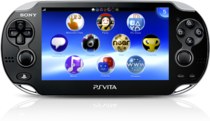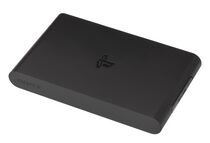PlayStation Vita emulators

| |
| PS Vita (PCH-1000) | |
| Developer | Sony |
|---|---|
| Type | Handheld game console |
| Generation | Eighth generation |
| Release date | December 2011 (Japan) February 2012 (North America) |
| Discontinued | 2019 |
| Predecessor | PlayStation Portable |
| Emulated | ✓ |
- For other emulators that run on PS Vita hardware, see Emulators on Vita.
The PlayStation Vita (PS Vita) is an eighth-generation handheld game console by Sony Interactive Entertainment, released in Japan on December 17, 2011, and in North America on February 15, 2012 and retailed for $249. It had a quad-core ARM Cortex-A9 MPCore at 333 MHz (Boosted to 499 MHz when overclocked) with one of its cores reserved for the OS, 512 MB of RAM, 128 MB of VRAM, a quad-core PowerVR SGX543MP4+ GPU, which can push 133 million polygons onto the screen every second at a clock speed of 166 MHz, and a custom sound and image processor called Venezia. It also features most of the PSP hardware, but it's been officially used only for backwards compatibility purposes.
Contents
Emulators[edit]
| Name | Platform(s) | Latest Version |
PlayStation TV | Hardware features | Enhancements | Compatibility | FLOSS | Active | Recommended |
|---|---|---|---|---|---|---|---|---|---|
| PC / x86 | |||||||||
| Vita3K | git | ✓ | ~ | ~ | 57% 1178 out of 2083 reported titles |
✓ | ✓ | ✓ | |
| Mobile / ARM | |||||||||
| Vita3K | 0.1.9-9 | ✓ | ~ | ~ | 57% 1178 out of 2083 reported titles |
✗ | ✓ | ✓ | |
- Vita3K
- Vita3K, an open-source PS Vita emulator, has seen significant advancements in recent years, particularly in game compatibility. It is the best and only Vita emulator for PC and Android currently.
The RPCS3 developers once considered adding Vita emulation support, going as far as displaying a simple 'Hello world' and a basic atomic test sample.[1] However, Vita development was completely halted since then and focused exclusively on PS3 emulation down to the website's branding. A Patreon post admitting as much asked users whether they are still interested in Vita emulation. Significant further developments on Vita coming from RPCS3 aren't very likely considering the general lack of developer interest, and those like frangarcj, who went on to join Vita3K. The RPCS3 project has since removed Vita support from the codebase.[2]
Enhancements[edit]
| Name | Vita3K | |||
|---|---|---|---|---|
| Graphics | Resizable Internal Resolution | ✓ | ||
| Ultrawide hack Widescreen already supported on PSVita system. But there is no support by system for render games in other ratios such as ultrawide 21:9 or super ultrawide 32:9. |
✗ | |||
| Texture Replacement | ✓* | |||
| Ray-tracing (DXR, VRT and MRT) |
Implementing ray-tracing in an emulator is unfortunately quite challenging and unlikely to be feasible in the near future. However you can try "Screen-Space Ray Traced Global Illumination" shader using ReShade. | |||
| Pre-rendering AA (MSAA, SSAA) |
✗ | |||
| Super-resolution techniques (DLSS, XeSS and FSR 2+) |
Requires access to the depth buffer and temporal data like motion-vectors so it's quite challenging and unlikely to be feasible in the near future. Besides any GPU that can use DLSS can run Vita3K at 4k native with ease anyway. | |||
| RTX Remix | Implementing RTX Remix technology in an emulator is unfortunately quite challenging and unlikely to be feasible in the near future. | |||
| Performance | Overclock | ✗ | ||
| Internal Framerate Hack | ✓* | |||
| Frame generation technologies (LSFG, DLSS-G, ExtraSS and AFMF) |
Implementing frame generation technology in an emulator is unfortunately quite challenging and unlikely to be feasible in the near future, however post-processing techniques such as motion interpolation is quite possible. Input latency will be a crucial factor, but its impact likely varies depending on the specific technique employed, it's recommended to use after applying the "Internal Framerate Hack". While AFMF or LSFG could be used with Vita3K?, please be aware that some visual glitches and artifacts may occur at this time. | |||
| Rendering latency reduction technologies (LatencyFleX, Reflex and Anti-Lag+) |
While most emulators offer frame pacing or framebuffer latency control options, implementing rendering latency reduction technologies isn't currently feasible. This is likely doesn't offer enough benefit to justify the development effort. | |||
| Preload ROM image to RAM For users with sluggish multi-platter HDDs or plagued by horrible seek times, this enhancement might offer smoother experience, potentially reduced power consumption; it also shines when images reside on a network drive. Although keep in mind that preloading image would take some time, and it will require additional amount of RAM capacity. |
✗ | |||
| Post-Processing | Post-rendering AA (FXAA, TXAA and MLAA/SMAA) |
✓ | ||
| Post-rendering scaling (Sharp bilinear, Lanczos and FSR 1) |
✓ | |||
| Filters | ✗ | |||
| AI-powered filter compatible (Freestyle) |
? | |||
| Shader Chain | ✗ | |||
| Inverse tone mapping compatible | ? | |||
| TAS features | Macros/Scripts/Lua | ✗ | ||
| Rewind | ✗ | |||
| Fast-Forward/Turbo Speed | ✗ | |||
| Savestates | ✗* | |||
| Movie recording/playback | ✗ | |||
| Controls | Mouse Injector Compatible | ✗ | ||
| Input lag-mitigating technique | ✗ | |||
| Quality of life | Built-in Graphics mod editor/manager | ✗ | ||
| Built-in Cheat Manager | ✗ | |||
| Streamable compression format | ✗ | |||
| Per-Game Profiles | ? | |||
| Command Line Options | ? | |||
| Variable Refresh Rate compatible | ? | |||
| Big Picture Mode | ✗ | |||
| Misc | RetroAchievements | ✗ | ||
| EmuVR support | Exclusive to libretro cores. So there is no support at the moment. | |||
| Debug Features | ✗ | |||
Hardware features[edit]
| Name | Vita3K | |
|---|---|---|
| Front and Rear Cameras | ✗ | |
| Microphone | ✗* | |
| Controls | Motion Sensor | ✗* |
| Touchscreen | ✓ | |
| Multi-Touch | ~[N 1] | |
| Rear Touch Pad | TBD | |
| Communication | PS3 Communication | ✗ |
| PS4 Communication | ✗ | |
| PlayStation Network | ✗* | |
| Ad-Hoc | ✗* | |
| Infrastructure | ✗* | |
| GPS | TBD | |
| Location Data Acqusition Service | TBD | |
| System Software | LiveArea and apps | ~ |
| PlayStation Mobile | ✗ | |
| Trophies | WIP | |
| PlayStation emulation (for PSOne Classics*) |
✗ | |
| PSP emulation for Digital PSP titles (incl. PSP Minis and PSP Remasters) |
✗ | |
- ↑ There is no multi-touch feature support for PC currently. Steam Deck support this feature but it has issues at the moment. Multi-touch feature was implemented with this pull request.
LiveArea and apps[edit]
LiveArea is a graphical user interface developed by Sony Computer Entertainment. You can launch various applications from this interface as well.
- Vita3K has pull request for this feature at the moment.
Trophies[edit]
Trophies are PlayStation Network awards presented to players for completing specific tasks in a game. The feature is present in most PlayStation 3 games, and all PlayStation Vita, PlayStation 4 and PlayStation 5 games.[1] Trophies shouldn't be confused with RetroAchievements.
- Vita3K has partially supports Trophies at the moment. See SceNpTrophy.cpp for current situation. Also Vita3K has built-in manager for Trophies (Using Vita3K GUI-Trophy Collection application).
PS3 communication[edit]
Remote play (via the PS3 system's wireless LAN), copying games to play on a PSVita system that can be played on either PS3 or PSVita systems etc.[3][4]
PlayStation TV[edit]

| |
| Developer | Sony |
|---|---|
| Type | Microconsole |
| Generation | Eighth generation |
| Release date | November 2013 (Japan) October 2014 (North America) |
| Discontinued | 2016 |
| Emulated | ✓ |
The PlayStation TV (PSTV) was a microconsole released by Sony in 2013 that essentially served as a home console version of the PlayStation Vita handheld gaming device. It allowed users to play a large library of PlayStation Vita games on their TVs. In addition to playing Vita games, the PlayStation TV offered remote play functionality, enabling users to stream games from their PS4 consoles to their TVs. While the PlayStation TV was initially marketed as a companion device to the Vita, it was discontinued in 2016.
References[edit]
- ↑ PS Vita emulation progress. emunewz (2014-11-02)
- ↑ Remove Vita emulation (Nekotekina). GitHub (2018-02-09)
- ↑ PS3 Remote Play with PSVita
- ↑ Connect PS Vita System Using Network
External links[edit]
- PS Vita Dev Wiki
- Wiki for homebrew development on PS Vita (Official site)
- Development tools for PS Vita development (APIs)
- PSVita Reverse Engineering Tools (Solely used to aid in homebrew / plugins / hacks development)